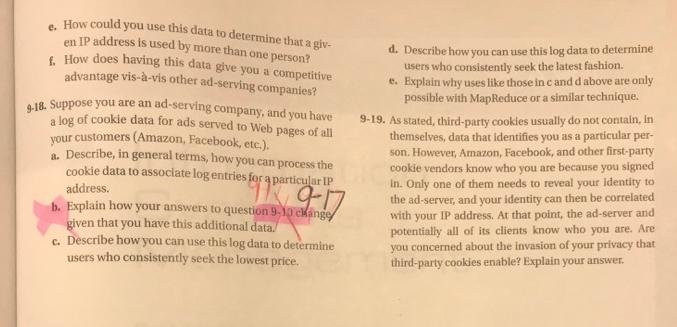Answered step by step
Verified Expert Solution
Question
1 Approved Answer
A cookie is data that a Web site stores on your computer to record something about its interaction with you. The cookie might contain



A cookie is data that a Web site stores on your computer to record something about its interaction with you. The cookie might contain data such as the date you last visited, whether you are currently signed in, or something else about your in- teraction with that site. Cookies can also contain a key value to one or more tables in a database that the server company maintains about your past interactions. In that case, when you access a site, the server uses the value of the cookie to look up your history. Such data could include your past purchases, portions of incomplete transactions, or the data and appear- ance you want for your Web page. Most of the time cookies ease your interaction with Web sites. Cookie data includes the URL of the Web site of the cookie's owner. Thus, for example, when you go to Amazon, it asks your browser to place a cookie on your computer that includes its name, www.amazon.com. Your browser will do so unless you have turned cookies off. A third-party cookie is a cookie created by a site other than the one you visited. Such cookies are generated in several ways, but the most common occurs when a Web page includes content from multiple sources. For example, Amazon designs its pages so that one or more sections contain ads provided by the ad-servicing company, DoubleClick. When the browser constructs your Amazon page, it contacts DoubleClick to ob- tain the content for such sections (in this case, ads). When it responds with the content, DoubleClick instructs your browser to store a DoubleClick cookie. That cookie is a third-party cookie. In general, third-party cookies do not contain thei name or any value that identifies a particular user. Instead, they include the IP address to which the content was delivered. On its own servers, when it creates the cookie, DoubleClick records that data in a log, and if you click on the ad, it will add that fact of that click to the log. This logging is repeated every time DoubleClick shows an ad. Cookies have an expiration date, but that date is set by the cookie creator, and they can last many years. So, over time, DoubleClick and any other third-party cookie owner will have a history of what they've shown, what ads have been clicked, and the intervals between interactions. But the opportunity is even greater. DoubleClick has agree- ments not only with Amazon, but also with many others, such as Facebook. If Facebook includes any DoubleClick content on its site, DoubleClick will place another cookie on your com- puter. This cookie is different from the one that it placed via Amazon, but both cookies have your IP address and other data sufficient to associate the second cookie as originating from the same source as the first. So, DoubleClick now has a record of your ad response data on two sites. Over time, the cookie log will contain data to show not only how you respond to ads, but also your pattern of visiting various Web sites on all those sites in which it places ads. You might be surprised to learn how many third-party cookies you have. The browser Firefox has an optional feature called Lightbeam that tracks and graphs all the cookies on your computer. Figure 9-30 shows the cookies that were placed on my computer as I visited various Web sites. As you can see, in Figure 9-30a, when I started my computer and browser, there were no cookies. The cookies on my computer after I visited www.msn.com are shown in Figure 9-30b. At this point, there are already eight third-party cookies tracking. After I visited five sites I had 27 third-party cookies, and after I visited seven sites I had 69, as shown in Figures 9-30c and d. Who are these companies that are gathering my browser behavior data? If you hold your mouse over one of the cookies, a. Display on Startup c. Five Sites Visited Yield 27 Third Parties Figure 9-30 Third-Party Cookie Growth Snounbe -Motila/ Lightbeam will highlight it in the data column on the right. As you can see in Figure 9-30d, after visiting seven sites, double- click was connected to a total of 16 other sites, only seven of which can be sites I visited. So, doubleclick is connecting to sites I don't even know about and on my computer. Examine the connection column on the right. I visited Msn, Amazon, Mynorthwest, Wsj, but who are Bluekai and Rubiconproject? I never heard of them until I saw this display. They, apparently, have heard of me, however! Third-party cookies generate incredible volumes of log data. For example, suppose a company, such as doubleclick. shows 100 ads to a given computer in a day. If it is showing ads to 10 million computers (possible), that is a total of 1 billion log entries per day, or 365 billion a year. Truly this is BigData. Storage is essentially free, but how can they possibly pro- cess all that data? How do they parse the log to find entries. just for your computer? How do they integrate data from dif- ferent cookies on the same IP address? How do they analyze those entries to determine which ads you clicked on? How do they then characterize differences in ads to determine which characteristics matter most to you? The answer, as you learned in Q6, is to use parallel processing. Using a MapReduce al- gorithm, they distribute the work to thousands of processors that work in parallel. They then aggregate the results of these b. After MSN.com and Gmail d Sites Connected to doubleclick independent processors and then, possibly, move to a second phase of analysis where they do it again. Hadoop, the ope source program that you learned about in Q6, is a favodite f this process. (See the collaboration exercise on pages 380-381 for a tinuation of the discussion: third-party cookies-problem opportunity?) QUESTIONS 9-16. Using your own words, explain how third-party cookies are created. 9-17. Suppose you are an ad-serving company, and yo maintain a log of cookie data for ads you serve to pages for a particular vendor (say Amazon). a. How can you use this data to determine which the best ads? b. How can you use this data to determine which ar the best ad formats? c. How could you use records of past ads and ad ca to determine which ads to send to a given IP add d. How could you use this data to determine how the technique you used in your answer to questo was working? e. How could you use this data to determine that a giv- en IP address is used by more than one person? f. How does having this data give you a competitive advantage vis--vis other ad-serving companies? 9-18. Suppose you are an ad-serving company, and you have a log of cookie data for ads served to Web pages of all your customers (Amazon, Facebook, etc.). a. Describe, in general terms, how you can process the cookie data to associate log entries for a particular IP address. 1919-77 b. Explain how your answers to question 9-10 change given that you have this additional data. c. Describe how you can use this log data to determine users who consistently seek the lowest price. d. Describe how you can use this log data to determine users who consistently seek the latest fashion. e. Explain why uses like those in c and d above are only possible with MapReduce or a similar technique. 9-19. As stated, third-party cookies usually do not contain, in themselves, data that identifies you as a particular per- son. However, Amazon, Facebook, and other first-party cookie vendors know who you are because you signed in. Only one of them needs to reveal your identity to the ad-server, and your identity can then be correlated your IP address. At that point, the ad-server and potentially all of its clients know who you are. Are you concerned about the invasion of your privacy that third-party cookies enable? Explain your answer. with
Step by Step Solution
★★★★★
3.46 Rating (175 Votes )
There are 3 Steps involved in it
Step: 1
Thirdparty cookies are created by websites other than the one you are currently visiting They are typically generated when a webpage includes content ...
Get Instant Access to Expert-Tailored Solutions
See step-by-step solutions with expert insights and AI powered tools for academic success
Step: 2

Step: 3

Ace Your Homework with AI
Get the answers you need in no time with our AI-driven, step-by-step assistance
Get Started


